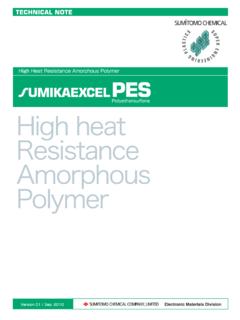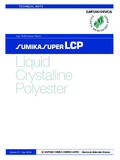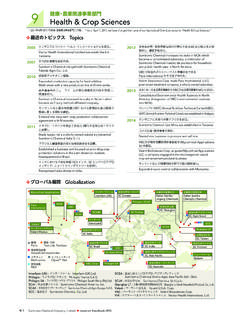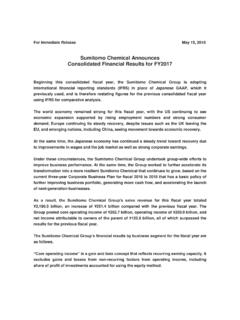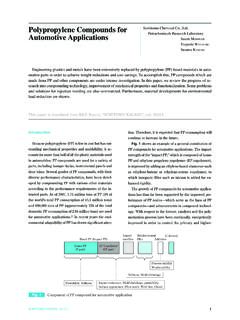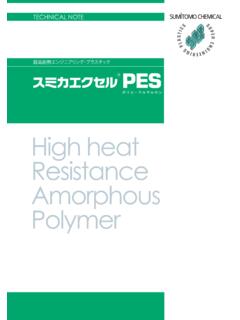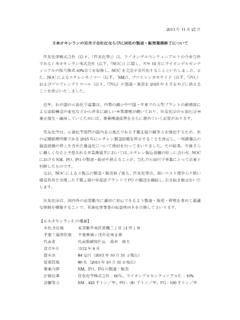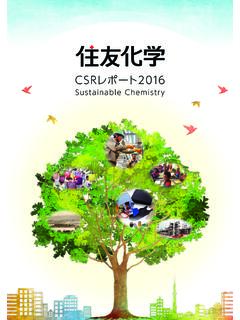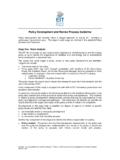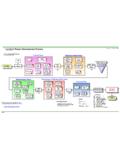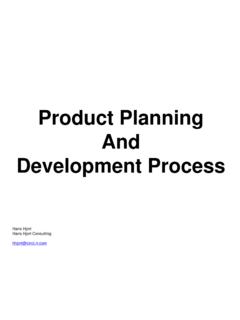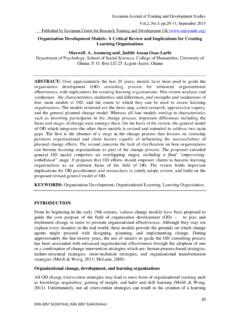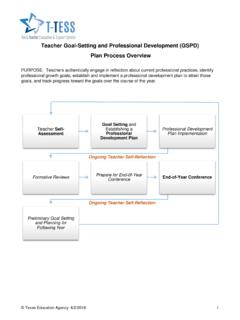Transcription of Review on Development of - Sumitomo Chem
1 1 Sumitomo KAGAKU 2009-IIIntroductionPolypropylene (PP) has the physical characteristicsof a low specific gravity, rigidity, heat resistance andsuperior workability. In addition, since it is compara-tively low in cost, it is used in a variety of applications,such as films, industrial components for automobiles,furniture, etc., and miscellaneous goods. It has beenmore than 50 years since 1954, when G. Natta et al. ofItaly were successful in synthesizing high molecularweight, highly crystalline PP,1)and the total worldwidedemand for PP has currently reached an amount ofapproximately 47 million tons (prediction for 2008).However, replacement of other materials and resins isprogressing even more, and moving forward, the fore-cast is for the highest growth rate among general pur-pose resins at an average of about 6% per )This flourishing of the PP market has been support-ed by the large improvements and simplification in themanufacturing process that had been accomplishedwith the leaps in catalyst performance.
2 Furthermore, inaddition to the characteristics of PP itself describedabove, the fact that there have been large improve-ments in the transparency and impact resistance at lowtemperatures through copolymerization with ethyleneand other alpha olefins has probably been an importantfactor. With the increase in the level of requirementsfor quality in recent years, a variety of ideas and con-trivances have been integrated into the manufacturingprocess for PP. In this paper, we will give a summary ofthe changes and the current state of the PP manufac-turing process based on information in the importantpatents and literature along with technologies devel-oped by Sumitomo in the PP Manufacturing ProcessThe PP manufacturing process is mainly made up of araw material refining process , polymerization process ,aftertreatment process and granulation process .
3 The rawmaterial refining process is the furthest upstreamprocess and is a process for eliminating minute amountsof impurities that affect the process , such as water, oxy-gen, carbon monoxide, carbon dioxide, carbonyl sulfideand the like, from the propylene and other monomers aswell as the solvents and other raw materials and auxil-iary materials used. Moreover, this process may be setup at a raw material manufacturing plant positionedupstream of the PP manufacturing plant, but in eithercase, it is a fundamentally necessary process for stabi-lization of the overall process . The polymerizationprocess is a process for polymerization that brings thepropylene and, if necessary, ethylene and othermonomers into contact with a catalyst having polymer- Review on Development ofPolypropylene ManufacturingProcessSumitomo Chemical Co., & Production Technology CenterHideki SATOH iroyuki OGAWAP olypropylene (PP) is a typical commodity plastic and has been widely used in many application fieldsincluding packaging films, industrial components and miscellaneous goods, due to its excellence in propertiessuch as stiffness, heat resistance and processability in addition to light weight material density and also arelatively low price.
4 The continued demands from the market for higher performances have stimulated,particularly in recent time, the improvement of PP manufacturing processes with newly created ideas. Thisreview describes, mainly based on the information published in literature and patents, an outline of thedevelopment history of PP manufacturing processes and an introduction to recent progress, including our paper is translated from R&D Report, Sumitomo KAGAKU , vol. KAGAKU 2009-IIReview on Development of Polypropylene Manufacturing Processization activity. Most of the main industrial catalysts arein a granular shape. The main catalysts are mostly in theform of secondary or tertiary particles of several tens of m that are aggregations of primary molecules havingdiameters of several hundred angstroms. The polymer-ization reaction occurs at the active points of the catalystparticles, and the PP that is formed precipitates out, andthe catalyst splits into primary particles.
5 However, thereare few deviations in the shape of the catalyst, and thisforms PP particles that resemble the original aggregatedcatalyst )The aftertreatment process is a processfor eliminating catalyst residue, the solvent and atacticpolymers (AP: noncrystalline polymers where themethyl groups of propylene units are arranged irregular-ly on the chain), which are components that are unnec-essary, from the PP particles obtained in thepolymerization process . Of these, the operation for elimi-nating the catalyst is known as addition, when a solvent is used in the polymeriza-tion process , a process for recovering and purifying itis included. The granulation process is the furthestdownstream process , and it is a process for meltingand kneading additives and fillers into the PP particlesthat have undergone the after-processing and recent years, there are cases where large diameterPP particles are shipped directly without granulationthrough improvements in the catalyst performance,methods of stabilizer distribution, etc.
6 However, this islimited to a few examples still, and it has not come tothe point of completely eliminating the )Moreover, storage, packaging and shipping,etc., are indispensable further downstream in commer-cial plants, but since they are not unique to PP manu-facturing processes, we will not touch on them in these processes, there have been particularlylarge improvements in simplifications for theaftertreatment process , such that they can be cited asa representative example of advances in chemical man-ufacturing processes. The PP manufacturing processcan be divided into three generations, the first genera-tion (deashing and AP removal), second-generation(non-deashing or non-solvent) and third-generation(non-deashing and non-AP removal) according to theseadvances in technology. In addition, classification canbe done according to the polymerization method intosolvent processes, bulk polymerization processes andvapor phase polymerization processes.
7 Fig. 1showsthe changes in the PP manufacturing processesarranged according to the processes required for therepresentative polymerization process for each genera-tion. Moreover, the furthest upstream raw materialrefining process and the downstream granulationprocess, which are fundamentally required in all ofthese processes, are omitted in Fig. will give a summary of these changes in PP man-ufacturing processes, using representative polymeriza-tion processes that Sumitomo Chemical has developedfor each Solvent polymerization processSince the PP particles are dispersed in the form of aslurry in the solvent with the solvent polymerizationprocess, this is also called the slurry polymerizationprocess, and it was a representative manufacturingprocess that was the main current in the first genera-tion. Fig. 2shows the first-generation solvent polymer-ization process developed by Sumitomo )The Sumitomo Chemical solvent polymerizationFig.
8 1 Polypropylene manufacturing process1st GenerationSolvent polymerization process2nd Generationa) Solvent polymerization process (Non-deashing)3rd GenerationVaper phase polymerization process (Non-deashing, Non-AP)DryingPPDegassingDeashingMonomer RecoverySolvent Recoveryb) Bulk polymerization process (Non-solvent)AP, AshAPAP, AshPolymerizationDryingPPDegassingMonome r RecoverySolvent RecoveryPolymerizationPPExtractionMonome r RecoveryPolymerizationPPPolymerization3 Sumitomo KAGAKU 2009-IIReview on Development of Polypropylene Manufacturing Processprocess was one that initially introduced technologyfrom the Italian company Montecatini, which was thefirst in the world to industrialize PP, but subsequentlySumitomo Chemical made a large number of technicalimprovements of its own and licensed them to a num-ber of polymerization used an autoclave providedwith an agitator for the reactor, and the conditions area temperature of 50 to 80 C and pressure of approxi-mately 1 MPa.
9 It is carried out in the presence of hexa-ne, heptane or another inert hydrocarbon solventwhere polymerization inhibitors have been the first generation, PP particles were obtainedafter going through separation and recovery of unreact-ed propylene, deashing (decomposition and elimina-tion of the catalyst using alcohol), washing in water,centrifugal separation and drying for the aftertreatmentprocesses. In addition, a process for separating the AP,which was produced as a secondary product at 10% ofthe amount polymerized was necessary at one time,and therefore, the AP was separated using its solubilityin the polymerization solvent. Not only was thisprocess complicated, but also the cost burden waslarge because of the separation and purification of theparticularly large amount of alcohol and water used indeashing from the solvent that was recovered.
10 Subse-quently, in the second generation, the deashingprocess was omitted because of improvements in cata-lyst activity, and the large amounts of alcohol and waterbecame the process was simplified in this manner, theomission of the process for eliminating secondary APhad to wait for the advent of superior catalysts thatgave a high level of stereoregularity that made possiblea reduction in the proportion of secondary AP generat-ed in addition to increasing the polymerization Bulk polymerization processThe bulk polymerization process is also called themass polymerization process , and solvents such ashexane and heptane are not used. It carries out poly-merization in liquefied propylene. It aims at simplifyingthe process by also using the propylene monomer,which is the raw material, as the no solvent other than the liquefied propyleneis used, the energy costs for the steam, electricity, etc.
